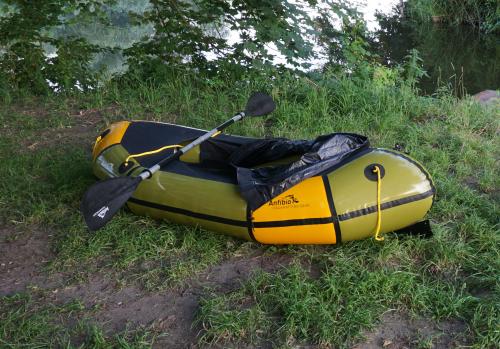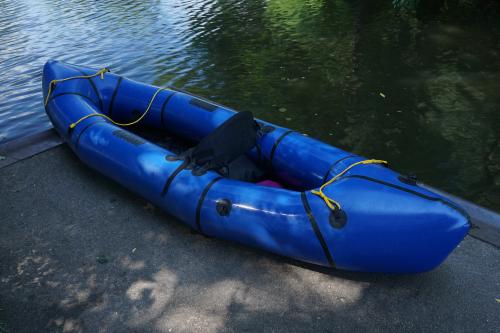Comparison: Anfibio Rebel 2K vs. MRS Nomad S1 Light
Previously I wrote about the Tour with the Anfibio Rebel 2K and I did the exact same tour with the MRS Nomad S1 Light.
MRS offers the S1 in the Light and the regular versions. I rented the Light version, but I also cover the regular version (that I own by now) in this post.
Spoiler Alert: I like the normal Nomad S1 better. I’ll explain why, don’t worry ;)
The following comparison will be based on the following aspects:
- The tour
- Boat specs
- Setup and dismantling
- Quality and material
- Equipment
- Driving behavior
- Speed
- Suitability for boat-trekking
- Price
The tour
Here are some basic information about the tour:
- Route: Identical for both boats (Dove Elbe and Gose Elbe near Hamburg, Germany)
- Distance: 19 km / 12 mi
- Water: calm, no current
- Wind:
- Tour with the Rebel 2K: No wind
- Tour with the Nomad S1: Head- and tailwind (gusts up to 20 km/h / 12 mph)
Boat specs
A complete overview can be found in a nice PDF file from the Packrafting Store, but here’s a summary:
| Property | Anfibio Rebel 2K | MRS Nomad S1 Light | MRS Nomad S1 |
|---|---|---|---|
| Weight (complete) | 2.3 kg / 5l bs | 3.5 kg / 7.7 lbs | 4.5 kg / 9.9 lbs |
| Length (outside) | 231 cm / 7’ 7" | 295 cm / 9’ 8" | 295 cm / 9’ 8" |
| Width (outside) | 91 cm / 2’ 12" | 87 cm / 2’ 10" | 87 cm / 2’ 10" |
| Fin | Yes | No (but with mount) | Yes |
| Spraydeck | Yes | No | Yes |
| Loops | 7 | 8 | 8 |
| Price1 | €799 | €1099 | €1499 |
Both boats have a seat with a backrest and enough loops to tighten your stuff.
Setup and dismantling
Setup and dismantling were nearly identical: Straightforward, self-explanatory and fast.
It took me about 20 minutes from arriving at the pier to start paddling. I neither dawdled nor was I in a hurry.
Quality and material
Quality
The workmanship is excellent for both boats, I haven’t found any weak spots or manufacturing defects yet. All seams are neatly welded/taped and there are no sharp edges.
Material
Both use 210D Nylon with a urethane coating for the tubes, so there are no differences here. Same for the seats, both use 210D Nylon.
The floor of both models is made of 840D Nylon (old variants came with 820D and 410D, which was already very robust).
Equipment

Fin & spraydeck
The table above shows that the Rebel 2K has a fin and spraydeck. The Nomad S1 Light has no spraydeck or fin, but a mount for a fin exists.
A spraydeck can not be added to the Nomad S1 Light. However, the regular Nomad S1 has both, a fin and spraydeck.
Mount and fin can, of course, be bought for a decent price.
Storage
Neither of the two tested models had “tube bags”, which are bags for stuff within the air-filled tubes, so I cannot say anything about those things. Both packrafts are available with optional tube bags.
The loops to strap on your stuff are on both boats roughly at the same places: Four at the front and then two at the back of the Rebel 2K and four at the back of the Nomad S1. However, the Rebel 2K has one additional loop at the front but on the inside.
The Rebel 2K has only two loops quite far back, which is unfortunate for tightening a backpack behind the seat. The Nomad S1, with its four loops, does a better job here. Anyway, both models have enough space and loops at the front, so a hiking backpack can easily be secured there.
Seat
The seat of the Nomad S1 is in the middle of the boat, so you can store stuff behind the seat. However, there’s not a lot of space, but a 20L bag fits in there. If you have the non-Light version, then the space is limited in height due to the spraydeck. A usual trekking backpack is too large for the space behind the seat and has to go to the front.
Both seats are more or less comfortable, so I don’t have real negative points here. The backrest of the S1 is – unlike the backrest of my Rebel 2K at the time – attached to the boat with small rods and straps, which gives a little more stability and I liked it better. In the current variant of the 2K, however, the comfort seat – contrary to the smaller standard seat – can also be attached, which stabilizes the seat and backrest.
Due to the improved design of the current Rebel 2K variant, you sit high enough (the seat is 16 cm / 6 in high) to use a normal 220 cm paddle. My seat at the time was lower, which made the paddle a little too short, a 230-240 cm / 90.5-95.5 in paddle would have been more suitable. With the Nomad S1, however, I had no problems because you generally sit nice and high in there.
Floor
Before trying the boats, I was unsure about the stability of the floor. It turned out, that my concerns were unfounded as both boats use a very thick and high-quality material of 840D Nylon.
Spoiler: In the meantime, I bought the regular Nomad S1 and the floor already slipped over some gravel and stones. So far, there are no signs of scratches at all.
Smell
Both rented boats smelled slightly like plastic, but not really strong. However, the freshly bought Nomad S1 smelled incredibly strong like plastic and it took several months until it was significantly less smelly. Unlike the Rebel 2K, the floor is also glued, which is why the smell is so strong. That’s really not nice but it went away and let’s face it: The boat consists of 100% plastic, so what did I expect?
Driving behavior

The Nomad S1 definitely has the better driving behavior due to its length. As mentioned above, the seat of the Rebel 2K felt lower, which is probably beneficial for stability, but paddling becomes a bit more difficult. The current Rebel 2K variant has a higher seat, which should make paddling easier.
The Rebel 2K is probably better suited for real white water situations. It was really fun to completely turn with only one paddling stroke, which is not possible with the S1. Therefore, I recommend the Nomad S1 for tours of multiple days.
However, both boats are stable in the water and I was not afraid to capsize.
Speed
The speed was definitely higher using the Nomad S1. Under nearly identical conditions, my tour with the S1 was about 1.5 times faster.
However, I cannot keep up with the speed of 6 km/h / 3.7 mph for the Nomad S1 and 4.5 km/h / 2.8 mph for the Rebel 2K given by the manufacturers. Calmly paddling and making breaks results in 3 km/h / 1.8 mph for the Nomad S1 and 2 km/h / 1.2 mph for the Rebel 2K.
Suitability for boat-trekking
Again, the Nomad S1 has some advantages here: The additional storage space behind the seat. It’s too small for a larger backpack but very useful for small things like a bottle of water, a hat and a jacket.
You can also store some stuff at the back of the Rebel 2K, but the loops are at unfortunate positions, so you have to be creative here.
If you place your big backpack at the front of the boat, you don’t have a free field of view, but at least there’s plenty of space. And if you always put heavy stuff near the floor, stability is still no problem.
Price
Well, the price.
This one goes to the Rebel 2K, especially if we look at the regular and more expensive version of the Nomad S1. If you don’t want to do longer trips, then the cost-effectiveness of the Rebel 2K is definitely better.
If you plan a longer tour, then you need to have a serious conversation with your wallet and then decide ;)
Luckily there are actual alternatives for the S1, for example, the Sigma TXL or other hybrid packrafts, which are made for 1-2 persons.
Conclusion
For me the Nomad S1 is the better Packraft (especially the normal version with the fin and spraydeck). But I’m planning for calmer and longer trips and especially the additional storage capacity and better driving behavior convinced me.
Update
In August 2021 I bought the regular version of the Nomad S1. I’m very happy with this choice and, of course, made a few longer trips with it:
-
Prices as of 03.05.2023 and approx. the same in US $ (maybe a bit less). ↩︎